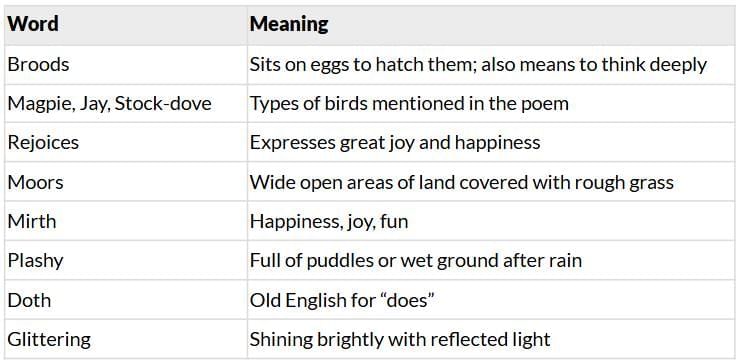Summary: After the Storm | Gul Mohar Class 6: Book Solutions, Summaries & Worksheets PDF Download
| Table of contents |

|
| About the Poet |

|
| Detailed Summary (Stanza-by-Stanza Explanation) |

|
| Moral / Message |

|
| Vocabulary Table |

|
About the Poet
William Wordsworth (1770–1850) was a leading English Romantic poet. He is famous for his deep love of nature and his ability to see beauty and joy in simple, everyday things. He believed that nature could heal, inspire, and bring peace to human beings. His best-known poems include The Solitary Reaper and I Wandered Lonely as a Cloud.
Detailed Summary (Stanza-by-Stanza Explanation)
Stanza 1
There was a roaring in the wind all night;
The rain came heavily and fell in floods;
But now the sun is rising calm and bright;
The birds are singing in the distant woods;
Over his own sweet voice the Stock-dove broods;
The Jay makes answer as the Magpie chatters;
And all the air is filled with pleasant noise of waters.
Explanation:
The poet recalls a storm that raged throughout the night, with strong winds roaring and heavy rains flooding the land. Such a storm might have seemed frightening and destructive. But the new morning brings a complete change—the sun rises peacefully, shining brightly, and filling the world with warmth. Birds begin to sing again: the Stock-dove softly brooding over its own song, the Jay responding, and the Magpie chattering cheerfully. Streams and rivers, filled with fresh rainwater, create a gentle, musical sound in the air. This contrast between the violent storm and the calm morning shows nature’s power to both destroy and heal.
Stanza 2
All things that love the sun are out of doors;
The sky rejoices in the morning's birth;
The grass is bright with rain-drops;—on the moors
The hare is running races in her mirth;
And with her feet she from the plashy earth
Raises a mist, that, glittering in the sun,
Runs with her all the way, wherever she doth run.
Explanation:
In this stanza, Wordsworth paints a lively picture of nature’s joy after the storm. Every creature that loves sunlight comes outside to enjoy the fresh morning. The sky itself seems happy, glowing with the “birth” of a new day. The grass shines with sparkling raindrops left from the storm. On the open moors (wild grasslands), a hare playfully races around in delight. As it runs over the wet ground, its feet throw up droplets of water that look like a glittering mist in the sunlight. This sparkling mist seems to run alongside the hare, almost like a playful companion. The scene reflects pure joy, freedom, and the renewal of life after a dark night of storm and destruction.
Moral / Message
- The poem highlights the beauty of renewal in nature. Storms and hardships do not last forever—they are often followed by peace, sunshine, and joy.
- Wordsworth suggests that life, like nature, has both dark and bright moments.
- We must learn to appreciate the calm, beauty, and happiness that follow struggle.
- The poem encourages us to notice the simple joys around us—birds singing, animals playing, the freshness of morning—and find hope and comfort in them.
Vocabulary Table

|
30 videos|61 docs|17 tests
|
FAQs on Summary: After the Storm - Gul Mohar Class 6: Book Solutions, Summaries & Worksheets
| 1. What is the main theme of the poem "After the Storm"? |  |
| 2. How does the poet use imagery to convey emotions in the poem? |  |
| 3. What moral or message can be derived from "After the Storm"? |  |
| 4. Can you explain the significance of the title "After the Storm"? |  |
| 5. How does the poem relate to the natural world? |  |















